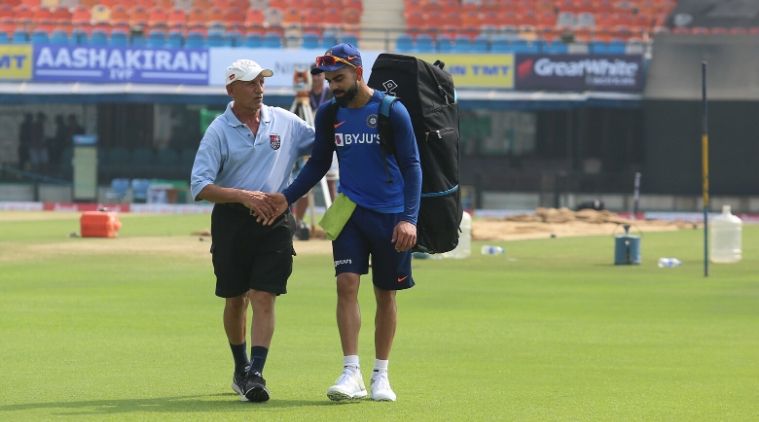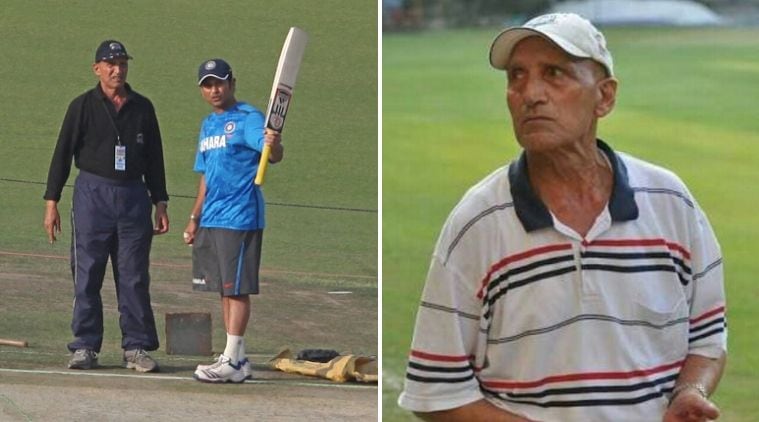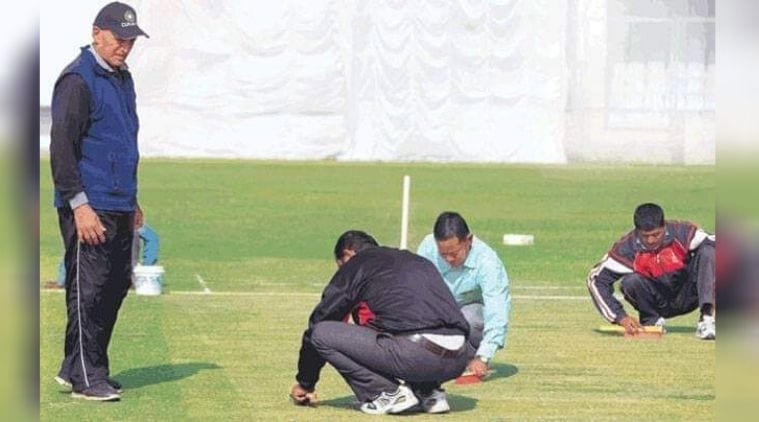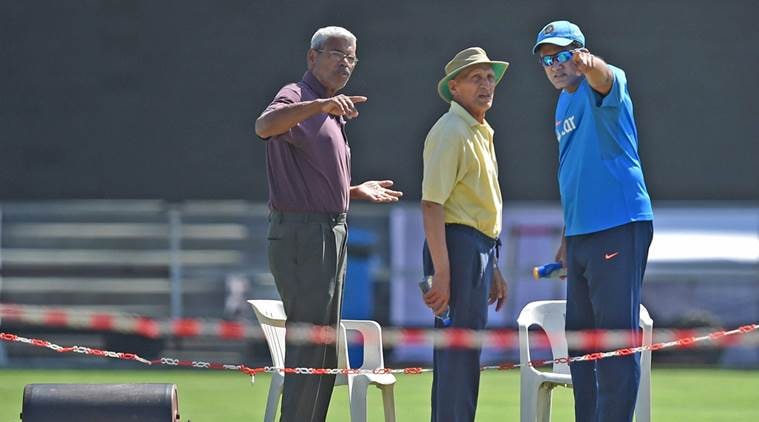 Daljit Singh with Indian skipper Virat Kohli after a practice session in 2019. (Express photo by Kamleshwar Singh)
Daljit Singh with Indian skipper Virat Kohli after a practice session in 2019. (Express photo by Kamleshwar Singh)
Daljit Singh has led Bihar in the Ranji Trophy, coached the same side years later, and was the longest-serving chairman of BCCI’s Ground and Pitch Committee. The 78-year-old speaks with the indianexpress.com about the challenges of maintaining pitches during lockdowns, what sort of pitches should games be played on and lessons from past controversies.
Need two weeks notice before a match
Singh, who headed BCCI’s Ground and Pitch Committee for 12 years till his retirement in 2019, still looks after the Punjab Cricket Association’s (PCA) Mohali ground. He admits the nationwide lockdown to slow the spread of Covid-19 made his job more challenging.
“Our staff faced problems in reaching the grounds due to the administrative restrictions. Somehow, we got permission for five members. They come daily and sprinkle water on the surface to help avoid dryness and cracks. Once a week, we also cut the outfield grass,” says Singh.
Though there are no cricket matches planned for the near future, Singh says they need just two weeks to get the pitches ready.
“This is a grass growing season in India. So all we will need is to de-thatch the grass. A two weeks’ notice before the match would be good enough,” he says.
#TeamIndia Captain @imVkohli & Head Coach @RaviShastriOfc felicitate BCCI Chief Curator Daljit Singh for his unparalleled services to Indian Cricket. pic.twitter.com/H28lxdsnuF
— BCCI (@BCCI) September 18, 2019
Associated with the PCA Mohali since 1993, Singh says he doesn’t take a penny for his services that have evolved over the years.
“I started when there was nothing. We would call ourselves maalis (gardeners). With a lot of studies, experiments and reasoning, we could become a qualified lot. Our ground staff across the country are well equipped with the best modern technology now,” he said.
On Kumble’s suggestion about spinner-friendly wickets
Singh admits there is little certainty about how cricket will proceed in a post-Covid-19 world given the ICC is still unclear about the rules. However, he’s not entirely sold on Anil Kumble’s suggestion to curate spinner-friendly wickets following the restart of cricket.
“I have been Kumble’s coach from 1988 to 1993 in Bengaluru. I know him well and he has always been for spinners, especially when he was the chairman of BCCI’s Technical Committee. But I am of the opinion that we should not make pitches favouring spinners, pacers or even batsmen. Let’s make our domestic cricket more competitive, keeping international tours in mind,” says Singh.
Singh stressed on the need for quality cricket in the domestic circuit, and says Kumble’s suggestion to play two spinners in foreign tours is unlikely to work everywhere since bowlers may not be able to grip the ball properly in cold and windy conditions.
 Sachin Tendulkar with Daljit Singh during a practice session at Mohali in 2013. (Express Photo by Kamleshwar Singh)
Sachin Tendulkar with Daljit Singh during a practice session at Mohali in 2013. (Express Photo by Kamleshwar Singh)
Rank Turners vs Green Tops
Singh says he began curating pitches almost by accident. He played Ranji cricket for 19 years for four different teams. As wicketkeeper, he once held the record for most dismissals (187 in 67 Ranji games). He scored a century in his last game (121 & 45*) for Bihar against Bombay at the age of 37 in 1979.
“I was in Bengaluru, working as a coach. Then (former BCCI and PCA chief) IS Bindra brought me to Mohali. I was the coach and additional responsibility of supervising the ground was handed to me. From there, I developed a deep interest in pitch curations and ground maintenance,” he says.
“Earlier, India was seen as the home for flat wickets, helping only spinners. Indian pacers had a tough time. Then calls for seamer-friendly wickets echoed and green top wickets became the trend. Now we are striking a balance. A proper four or five-day pitch must help seamers on the Day 1, batting on Day 2, and spin and swing on Day 3 and 4,” Singh says.
 The veteran curator has also enjoyed his time as a first-class player and a coach before taking up BCCI’s offer. (Archive)
The veteran curator has also enjoyed his time as a first-class player and a coach before taking up BCCI’s offer. (Archive)
Singh cites figures from Ranji Trophy results to show that only result-oriented pitches are being made.
“There was a time in the Indian domestic season that home teams were curating rank turners to take advantage and matches were getting over in two days’ time. I took it to the board and the concept of a neutral curator came in place. They can’t be influenced or pressurised. Now you won’t find a single pitch in India spinning from day 1. Ranji Trophy had just 42 per cent results a few years back, now over 62 per cent matches have results,” the former wicketkeeper-batsman said.
Lessons from controversies
As long-serving head of the curation team, there have been instances when Singh tried to heed requests of the home team with disastrous results.
In December 2009, an India vs Sri Lanka ODI was called off due to unfit playing conditions at Delhi’s Feroz Shah Kotla. The pitch committee headed by Singh was disbanded. The team was reinstated only after an ICC fact-finding report.
“The then DDCA (Delhi & District Cricket Association) president Arun Jaitley had asked me to curate the pitches, which were some 40-years-old. I prepared them all over again in August that year and told them that it would play low in the first season, as we saw in Champions League T20 and India vs Australia ODI in September,” he says.
“Having seen the low nature of the newly built pitch, DDCA got the pitch relaid just a couple of weeks before the India vs Sri Lanka match. My expertise was ignored,” Singh says.
 BCCI had disbanded the pitch committee headed by Daljit Singh. (Archive)
BCCI had disbanded the pitch committee headed by Daljit Singh. (Archive)
Singh says it wasn’t the fault of curator’s team but, as the ICC’s fact-finding report stated, it was DDCA’s unprofessionalism that backfired.
A similar controversy erupted in 2017 when India lost to Australia in the first Test of the four-match series. The match ended in three days as India failed to apply themselves on a track that was turning square from the first day. The hosts capitulated to a 333-run defeat that ended their unbeaten streak of 19 Test matches.
 The then coach Anil Kumble chats with curators Daljit Singh and MCA curator Pandurang Salgoankar in Pune. (Source: PTI)
The then coach Anil Kumble chats with curators Daljit Singh and MCA curator Pandurang Salgoankar in Pune. (Source: PTI)
“The board and the team desperately wanted a rank turner. There was so much pressure to keep the surface totally bald…just to toe the home team’s line, we over-reached it. Nobody can be proud of that pitch. It could have been done in a better way,” Singh admits.
In these controversies, Singh sees lessons for future pitch curators.
“It’s not the home team captain or the board secretary who will evaluate the pitch, It’s the match referee who will decide it. So just to please the home team, one should not go overboard. A slight home advantage is fair enough, but no more than that,” he says.